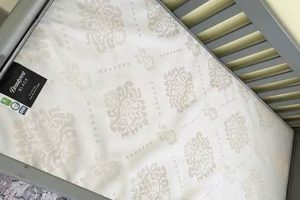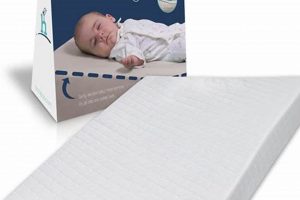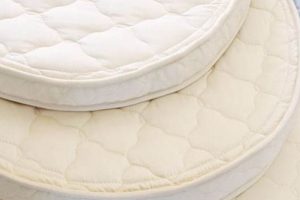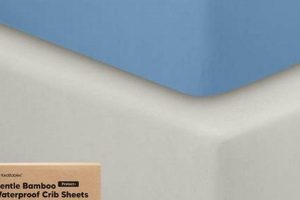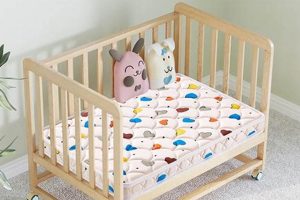A fitted fabric covering designed specifically to encase a crib mattress, providing a sanitary and comfortable sleep surface for infants. These coverings are typically made from materials like cotton, flannel, or blends thereof, and are available in various sizes to ensure a snug and secure fit on standard crib mattresses. Their primary function is to protect the mattress from spills, accidents, and general wear and tear, while also offering a soft and breathable layer against a baby’s skin.
The use of appropriately sized and well-maintained mattress coverings in infant sleep environments is crucial for hygiene, safety, and comfort. A properly fitted covering reduces the risk of suffocation or entanglement hazards associated with loose bedding. Furthermore, regular washing of the covering helps to eliminate allergens, bacteria, and other irritants, promoting a healthier sleep environment for the child. Historically, such coverings evolved from simple cloths placed over mattresses to specifically designed, elasticized products ensuring a secure fit.
The subsequent sections will delve into the various types of materials used in their construction, safety standards to consider when selecting one, proper washing and care instructions, and factors influencing purchasing decisions.
Essential Guidance
The following recommendations are critical for ensuring infant safety and optimal use. Adherence to these guidelines contributes to a secure and hygienic sleep environment.
Tip 1: Prioritize Fit. A properly fitted covering is paramount. Ensure the covering is specifically designed for the size of the crib mattress and fits snugly without any looseness. A loose covering presents a suffocation hazard.
Tip 2: Select Breathable Materials. Opt for coverings made from breathable materials such as cotton or muslin. These materials allow for air circulation, reducing the risk of overheating and promoting comfort.
Tip 3: Maintain Regular Washing. Wash the covering frequently, ideally every few days, using a gentle, hypoallergenic detergent. This practice eliminates allergens, bacteria, and other potential irritants.
Tip 4: Inspect for Damage. Regularly inspect the covering for tears, holes, or loose threads. Damaged coverings should be replaced immediately to prevent entanglement hazards.
Tip 5: Avoid Excessive Bedding. Refrain from using additional bedding items such as pillows, blankets, or bumper pads in the crib. These items pose a suffocation risk and are not recommended for infant sleep environments.
Tip 6: Consider Waterproofing. Consider a waterproof or water-resistant covering. This feature protects the mattress from spills and accidents, extending its lifespan and maintaining hygiene.
Tip 7: Research Safety Standards. Investigate manufacturers’ adherence to relevant safety standards and certifications. This ensures the covering has undergone testing for harmful substances and meets established safety criteria.
Consistent application of these guidelines enhances the safety and hygiene of the infant sleep environment, promoting better rest and reducing potential hazards.
The subsequent section will address frequently asked questions regarding the selection, care, and use of crib mattress coverings.
1. Secure fit
The term “secure fit,” when associated with covers for crib mattresses, denotes the crucial characteristic of the fabric encasement conforming precisely to the dimensions of the mattress without any looseness or slack. This precise fit is not merely a matter of aesthetic preference but directly impacts infant safety. A cover that is too large or inadequately elasticized creates a potential hazard; excess material can become dislodged, posing a suffocation or entanglement risk to the infant. Real-world instances have demonstrated tragic consequences arising from ill-fitting covers becoming bunched or wrapped around a sleeping infant’s face, obstructing breathing. Therefore, a secure fit is a fundamental functional requirement, not an optional attribute.
The practical implications of a secure fit extend beyond immediate safety concerns. A well-fitting cover also contributes to the longevity of the mattress itself. By preventing slippage and bunching, the cover minimizes friction and wear on the mattress surface. Furthermore, a snug fit ensures that the waterproof layer (if present) remains in consistent contact with the mattress, effectively preventing liquids from penetrating and causing damage. The availability of covers specifically designed for standard crib mattress dimensions simplifies the selection process, however, verification of the cover’s dimensions against the mattress’s actual measurements remains imperative.
In summary, the secure fit of a cover for a crib mattress is inextricably linked to infant safety and mattress longevity. Its importance stems from its direct role in mitigating suffocation risks and maintaining mattress integrity. Challenges persist in ensuring consistent sizing standards across manufacturers, underscoring the need for diligent measurement verification and careful selection. This aspect represents a critical component of the broader consideration of creating a safe and hygienic sleep environment for infants.
2. Breathable fabric
The selection of breathable fabric for covers used on crib mattresses is paramount due to its direct impact on infant thermoregulation and the reduction of Sudden Infant Death Syndrome (SIDS) risk. Fabrics like cotton, muslin, and bamboo allow air to circulate freely, dissipating heat and moisture away from the infant’s body. This minimizes the likelihood of overheating, a known risk factor for SIDS. Conversely, non-breathable fabrics, such as vinyl or tightly woven synthetics, trap heat and moisture, creating an environment conducive to hyperthermia. The cause-and-effect relationship between fabric breathability and infant safety is well-documented in pediatric sleep research.
The practical application of this understanding is evident in the widespread availability of crib mattress covers specifically marketed as “breathable.” These products often feature open-weave constructions or utilize fibers with inherent moisture-wicking properties. Furthermore, organizations like the American Academy of Pediatrics recommend the use of breathable bedding materials to promote infant safety. A real-life example illustrating the importance is parents in warmer climates consistently choosing lightweight cotton or muslin covers to prevent their infants from becoming overheated during sleep. Retailers have also responded by stocking more breathable options and providing informative labeling to guide purchasing decisions.
In summary, the connection between breathable fabric and covers used on crib mattresses is fundamentally linked to infant safety and well-being. While challenges persist in educating all caregivers on the importance of this attribute, the availability of breathable materials and informed purchasing decisions contribute to a safer sleep environment. The ongoing emphasis on breathable fabrics represents a critical component of broader efforts to reduce SIDS risk and promote healthy infant sleep practices.
3. Regular washing
Regular washing of the crib mattress sheet is not merely a routine hygiene practice; it is a critical component of maintaining a safe and healthy sleep environment for infants. The frequency and method of washing directly impact the reduction of allergens, bacteria, and potential irritants that can accumulate on the fabric surface. Understanding the nuances of this practice is essential for caregivers.
- Allergen Reduction
Crib mattress sheets are prone to accumulating allergens such as dust mites, pet dander, and pollen. These allergens can trigger allergic reactions in infants, leading to respiratory distress, skin irritation, and disrupted sleep. Regular washing, ideally at temperatures above 130F (54C), effectively eliminates these allergens, mitigating the risk of allergic responses. Studies have shown a significant reduction in dust mite populations with consistent washing schedules. Real-world examples include infants experiencing improved sleep quality and reduced eczema flare-ups following the implementation of regular sheet-washing routines.
- Bacterial Control
Infant spit-up, diaper leaks, and general drool can create a breeding ground for bacteria and fungi on crib mattress sheets. These microorganisms pose a risk of infection, particularly for infants with compromised immune systems. Regular washing with appropriate detergents effectively eliminates these pathogens, minimizing the risk of skin infections and other health complications. Hospitals and childcare facilities adhere to stringent washing protocols to prevent the spread of infections among infants and young children, highlighting the importance of this practice.
- Chemical Residue Removal
New crib mattress sheets may contain residual chemicals from the manufacturing process, including formaldehyde and other volatile organic compounds (VOCs). These chemicals can off-gas and potentially irritate an infant’s sensitive respiratory system. Regular washing, especially before initial use, helps to remove these chemical residues, reducing the risk of exposure. Consumer advocacy groups recommend pre-washing all infant bedding to eliminate potential chemical contaminants. Some manufacturers even pre-wash their crib mattress sheets and specify that on the packaging.
- Maintenance of Material Integrity
While frequent washing is essential, using harsh detergents or excessively high temperatures can degrade the fabric of the crib mattress sheet, compromising its integrity and potentially releasing microplastics. Employing gentle, hypoallergenic detergents and following the manufacturer’s washing instructions helps to maintain the sheet’s durability and prolong its lifespan. Selecting high-quality, durable fabrics that can withstand regular washing cycles is also crucial for ensuring long-term performance. This illustrates how proper care, guided by label instructions, contributes to both hygiene and product longevity.
In conclusion, regular washing of the crib mattress sheet is a multifaceted practice that extends beyond basic cleanliness. It plays a vital role in reducing allergen exposure, controlling bacterial growth, removing chemical residues, and maintaining the integrity of the sheet itself. Adhering to consistent washing schedules and employing appropriate washing techniques are essential components of creating a safe, hygienic, and comfortable sleep environment for infants, directly benefiting their health and well-being.
4. Hypoallergenic
The term “hypoallergenic,” when applied to crib mattress sheets, signifies a reduced potential to cause allergic reactions. This characteristic is of paramount importance given the sensitivity of infants’ skin and respiratory systems. The selection of hypoallergenic materials and manufacturing processes aims to minimize the presence of common allergens and irritants within the product.
- Material Composition
Hypoallergenic crib mattress sheets are typically constructed from materials known for their low allergenic potential. Examples include organic cotton, bamboo rayon, and Tencel. These materials are less likely to harbor dust mites, mold, and other common allergens compared to synthetic fabrics. The selection of these materials directly contributes to a reduced risk of skin irritation, eczema flare-ups, and respiratory issues in infants. Real-world scenarios demonstrate a preference for organic cotton sheets among parents whose infants have known skin sensitivities or allergies.
- Dye and Chemical Treatment
The dyeing and chemical treatment processes used in the production of crib mattress sheets can significantly impact their hypoallergenic properties. Harsh dyes, formaldehyde, and other chemical finishes can trigger allergic reactions in sensitive individuals. Hypoallergenic sheets are often manufactured using low-impact dyes and are free from harmful chemicals. Certifications such as OEKO-TEX Standard 100 ensure that the sheets have been tested for a wide range of harmful substances, providing an additional layer of assurance for parents and caregivers. Examples include infants developing contact dermatitis from sheets treated with formaldehyde, which resolves upon switching to certified OEKO-TEX hypoallergenic sheets.
- Construction and Weave
The construction and weave of the fabric can also influence its hypoallergenic properties. Tightly woven fabrics create a barrier against dust mites, preventing them from penetrating the sheet and coming into contact with the infant’s skin. Smooth surfaces also minimize friction and irritation. Examples include percale and sateen weaves, which are often preferred for their smooth texture and tightly woven construction. In practice, parents have reported reduced dust mite allergy symptoms in their infants when using tightly woven, hypoallergenic sheets.
- Washing and Care
Even hypoallergenic crib mattress sheets can accumulate allergens and irritants over time. Regular washing with hypoallergenic detergents is essential for maintaining their hypoallergenic properties. Harsh detergents and fabric softeners can leave behind residues that irritate sensitive skin. Opting for fragrance-free and dye-free detergents minimizes the risk of allergic reactions. Care instructions often recommend washing new sheets before initial use to remove any residual chemicals or manufacturing debris. Examples include infants experiencing skin irritation from sheets washed with scented detergents, which improves upon switching to hypoallergenic, fragrance-free options.
The considerations above illustrate the multifaceted nature of hypoallergenic crib mattress sheets. The combined effect of material selection, manufacturing processes, construction, and proper care contributes to a reduced risk of allergic reactions and a healthier sleep environment for infants. These factors must be carefully considered when selecting bedding for infants with sensitivities or a family history of allergies.
5. Waterproof option
The inclusion of a waterproof layer in crib mattress sheets represents a deliberate design feature intended to safeguard the mattress core from liquid penetration. This option addresses a significant practical concern for infant care, minimizing the potential for unsanitary conditions and extending the lifespan of the mattress.
- Protection Against Fluids
The primary function of a waterproof crib mattress sheet is to act as a barrier against liquids such as urine, spit-up, and spills. This protective layer prevents these fluids from seeping into the mattress, where they can foster bacterial growth, mold, and unpleasant odors. Real-world examples include parents finding that mattresses without waterproof sheets quickly become stained and emit foul odors, necessitating premature replacement. The implementation of a waterproof sheet mitigates these issues, preserving the cleanliness and hygiene of the mattress over time.
- Material Composition and Construction
Waterproof crib mattress sheets typically consist of multiple layers, including a top layer made from absorbent fabric (such as cotton or bamboo) and a backing layer made from a waterproof material (such as polyurethane or polyethylene). The waterproof layer is often laminated or bonded to the absorbent layer to create a single, integrated sheet. Some sheets utilize a breathable waterproof membrane, which allows air to circulate while still preventing liquid penetration. Examples include sheets using TPU (thermoplastic polyurethane) as a waterproof layer, prized for its flexibility and breathability compared to traditional PVC. The construction methods and materials employed directly influence the sheet’s effectiveness and durability.
- Impact on Hygiene and Health
By preventing liquid penetration and the subsequent growth of bacteria and mold, waterproof crib mattress sheets contribute to a more hygienic and healthier sleep environment for infants. The reduction of allergens and irritants minimizes the risk of allergic reactions, respiratory problems, and skin irritations. Studies have shown that mattresses with waterproof protection harbor fewer microorganisms compared to unprotected mattresses. Real-world consequences of using non-waterproof sheets include the development of mold allergies in infants due to mold growth within the mattress core, highlighting the direct impact on infant health.
- Maintenance and Longevity
Waterproof crib mattress sheets simplify the cleaning process, as spills and accidents can be easily wiped clean with a damp cloth. This reduces the need for frequent washing, which can extend the lifespan of the sheet. However, it’s still important to wash the sheet regularly to remove allergens and maintain hygiene. Furthermore, protecting the mattress core from liquid damage prevents premature deterioration and extends the overall lifespan of the mattress itself. This illustrates that using the waterproof sheet improves durability and cleanliness in the long term.
These varied characteristics of the waterproof option for crib mattress sheets collectively contribute to its value in providing a more sanitary and enduring sleep surface. While selection must also consider breathability and safety certifications, the protective capacity offers substantial benefits in maintaining a clean and hygienic sleep environment for infants.
6. Durable material
The selection of durable material in the construction of a crib mattress sheet is directly linked to the product’s longevity, safety, and overall value proposition. The cause-and-effect relationship is straightforward: higher durability translates to greater resistance against wear and tear, extending the useful life of the sheet. This is particularly crucial in the context of infant bedding, which is subjected to frequent washing, potential staining, and the general rigors of daily use. Without durable materials, the sheet is prone to premature degradation, requiring more frequent replacements and potentially exposing the infant to compromised sleep surfaces. For instance, a sheet made from low-quality cotton may develop holes or tears after only a few washes, rendering it unsafe and unhygienic. The importance of durable material as a fundamental component of a crib mattress sheet, therefore, cannot be overstated.
Practical significance arises in several areas. Crib mattress sheets constructed from durable materials such as tightly woven cotton blends, reinforced stitching, and quality elastic are demonstrably more resistant to shrinking, fading, and tearing. This reduces the frequency of replacements, representing a long-term cost saving for parents. Furthermore, more durable materials are better equipped to withstand rigorous washing cycles without losing their shape or integrity. This is vital for maintaining hygiene and preventing the accumulation of allergens or bacteria within the fabric. Real-life examples include parents consistently opting for organic cotton or linen blends for their superior durability and resistance to wear, even though the initial cost may be higher. They recognize this as an investment in the long-term safety and comfort of their child. Also a durable waterproof membrane provides a higher protection to the mattress core, because it does not brake so easily.
In summary, the emphasis on durable material in crib mattress sheets directly addresses the need for long-lasting, safe, and cost-effective bedding solutions for infants. Challenges remain in establishing consistent standards for material durability across different manufacturers and product lines. Consumers must therefore rely on a combination of product specifications, customer reviews, and brand reputation to make informed purchasing decisions. The choice of a durable crib mattress sheet is ultimately linked to the broader themes of infant safety, hygiene, and sustainable consumption, reflecting a commitment to both the well-being of the child and the long-term value of the product.
7. Safety standards
Adherence to established safety standards in the production and design of crib mattress sheets is paramount for safeguarding infant health and well-being. These standards aim to mitigate potential hazards associated with bedding products, ensuring that materials and construction methods meet defined criteria for safety and performance.
- Material Composition and Chemical Emissions
Safety standards dictate permissible levels of chemicals used in the manufacturing process. Certifications like OEKO-TEX Standard 100 ensure that crib mattress sheets are tested for harmful substances such as formaldehyde, phthalates, and heavy metals. The presence of these substances can pose risks to infants through skin contact or inhalation. Compliance with these standards minimizes the exposure of infants to potentially toxic chemicals. An example is the prohibition of certain flame retardants in crib mattress sheets due to their documented adverse health effects.
- Flammability Resistance
Flammability standards for crib mattress sheets are designed to reduce the risk of fire-related injuries. These standards mandate that sheets meet specific requirements for flame resistance, either through the inherent properties of the fabric or through the application of flame-retardant treatments. However, due to concerns about the safety of certain flame-retardant chemicals, some standards promote the use of inherently flame-resistant materials like tightly woven cotton or wool. Testing protocols assess the sheet’s ability to resist ignition and the rate at which flames spread.
- Fit and Dimensional Stability
Safety standards address the critical aspect of fit, ensuring that crib mattress sheets are appropriately sized and securely fitted to the mattress. Loose or ill-fitting sheets pose a suffocation and entanglement hazard to infants. Standards specify dimensional requirements and elastic strength to guarantee a snug fit that minimizes the risk of bunching or detachment. Regular laundering should not compromise the sheet’s ability to maintain a secure fit.
- Construction and Durability
Safety standards encompass aspects of construction and durability, ensuring that crib mattress sheets are manufactured to withstand regular use and washing without compromising safety. Standards may specify minimum requirements for seam strength, fabric tear resistance, and elastic durability. These requirements aim to prevent the sheet from developing holes, tears, or loose threads that could pose an entanglement hazard to infants. Sheets undergo testing to assess their ability to withstand repeated washing cycles without significant degradation.
The multifaceted nature of safety standards underscores their significance in providing a framework for responsible manufacturing and consumer protection. Adherence to these standards, verified through independent testing and certification, offers assurance that crib mattress sheets meet defined criteria for safety, contributing to a healthier and more secure sleep environment for infants.
Frequently Asked Questions
The subsequent section addresses common inquiries concerning crib mattress sheets, providing detailed information to aid in informed decision-making.
Question 1: What constitutes a “secure fit” for a crib mattress sheet, and why is it important?
A secure fit refers to a crib mattress sheet that conforms precisely to the dimensions of the mattress, without any looseness, bunching, or sagging. This is crucial because loose bedding poses a suffocation and entanglement hazard to infants.
Question 2: What materials are considered “breathable” and appropriate for crib mattress sheets?
Breathable materials facilitate air circulation, reducing the risk of overheating. Suitable options include cotton, muslin, bamboo rayon, and Tencel. Avoid non-breathable materials such as vinyl or tightly woven synthetics.
Question 3: How frequently should a crib mattress sheet be washed?
Crib mattress sheets should be washed regularly, ideally every few days, to eliminate allergens, bacteria, and other potential irritants. Always follow the manufacturer’s instructions for washing and drying.
Question 4: What characterizes a “hypoallergenic” crib mattress sheet?
A hypoallergenic crib mattress sheet is manufactured using materials and processes designed to minimize the risk of allergic reactions. These sheets are typically free from harsh dyes, formaldehyde, and other potential irritants, and are often made from organic cotton or bamboo.
Question 5: What are the benefits of a waterproof crib mattress sheet?
A waterproof crib mattress sheet protects the mattress core from liquids, preventing the growth of bacteria and mold, and extending the lifespan of the mattress. It simplifies cleaning and maintains a more hygienic sleep environment.
Question 6: How can adherence to safety standards be verified when purchasing a crib mattress sheet?
Verify that the crib mattress sheet has been certified by reputable organizations such as OEKO-TEX. This certification indicates that the sheet has been tested for harmful substances and meets established safety criteria. Review product descriptions and labels for safety-related information.
Careful consideration of these questions and answers contributes to a safer and more informed approach to selecting and using crib mattress sheets.
The subsequent section provides guidance on factors influencing purchasing decisions related to crib mattress sheets.
Conclusion
The preceding analysis of the crib mattress sheet has underscored its multi-faceted role in infant care. Beyond its function as a simple bedding component, the crib mattress sheet directly impacts infant safety, hygiene, and overall well-being. Key considerations, including secure fit, breathable materials, regular washing, hypoallergenic properties, waterproof options, durable construction, and adherence to safety standards, each contribute to the creation of a secure and sanitary sleep environment. These elements should not be viewed as optional enhancements, but rather as essential requirements for responsible infant care.
The selection and maintenance of an appropriate crib mattress sheet represent a critical responsibility for caregivers. A vigilant approach to material selection, product evaluation, and ongoing care practices is necessary to mitigate potential risks and promote healthy infant development. Continued research and awareness regarding crib mattress sheet safety standards are essential to safeguard the most vulnerable members of society.


